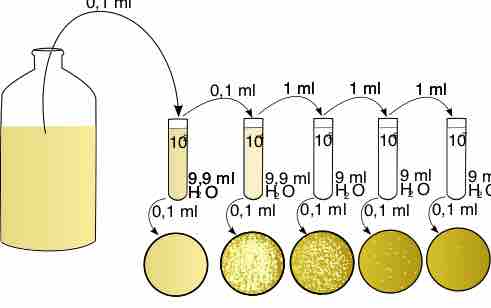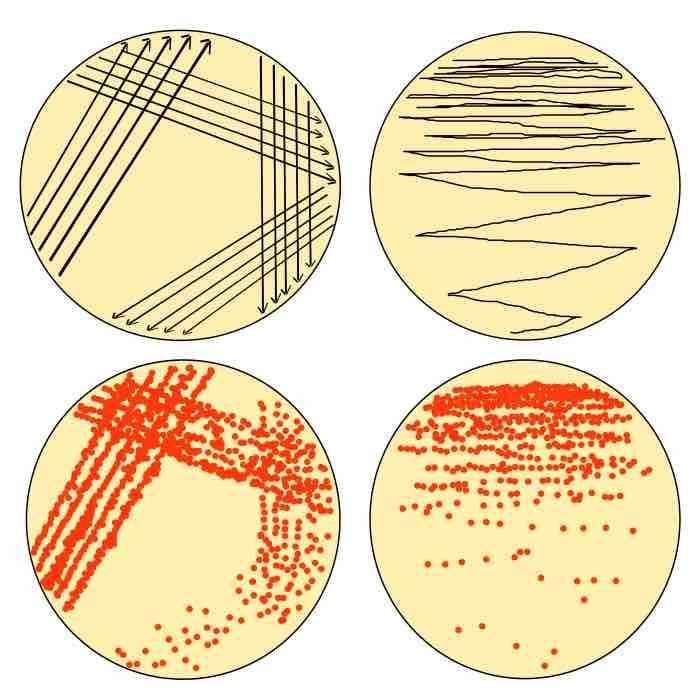Microbiologists have many tools, but four relatively simple techniques are used by microbiologists daily, these are outlined here.
Aseptic technique or sterile technique is used to avoid contamination of sterile media and equipment during cell culture. Sterile technique should always be employed when working with live cell cultures and reagents/media that will be used for such cultures. This technique involves using flame to kill contaminating organisms, and a general mode of operation that minimizes exposure of sterile media and equipment to contaminants.
When working with cultures of living organisms, it is extremely important to maintain the environments in which cells are cultured and manipulated as free of other organisms as possible. This requires that exposure of containers of sterilized culture media to outside air should be minimized, and that flame is used to "re-sterilize" container lids and rims. This means passing rims and lids through the flame produced by a Bunsen burner in order to kill microorganisms coming in contact with those surfaces.
Sterile technique, in general, is a learned state-of-being, or mantra, where every utilization of any sterile material comes with the caveat of taking every precaution to ensure it remains as free of contaminants as possible for as long as possible. Heat is an excellent means of killing microorganisms, and the Bunsen burner is the sterile technician's best friend.
A serial dilution is the step-wise dilution of a substance in solution. Usually the dilution factor at each step is constant, resulting in a geometric progression of the concentration in a logarithmic fashion. A ten-fold serial dilution could be 1 M, 0.1 M, 0.01 M, 0.001 M... Serial dilutions are used to accurately create highly-diluted solutions as well. A culture of microbes can be diluted in the same fashion. For a ten-fold dilution on a 1 mL scale, vials are filled with 900 microliters of water or media, and 100 microliters of the stock microbial solution are serially transferred, with thorough mixing after every dilution step. The dilution of microbes is very important to get to microbes diluted enough to count on a spread plate (described later).

Serial Dilution
Example of Serial dilution of bacteria in five steps. The diluted bacteria were then spread plated.By Leberechtc (Own work) [GFDL (http://www.gnu.org/copyleft/fdl.html) or CC-BY-3.0 (http://creativecommons.org/licenses/by/3.0)], via Wikimedia Commons
In microbiology, streaking is a technique used to isolate a pure strain from a single species of microorganism, often bacteria. Samples can then be taken from the resulting colonies and a microbiological culture can be grown on a new plate so that the organism can be identified, studied, or tested.The streaking is done using a sterile tool, such as a cotton swab or commonly an inoculation loop. This is dipped in an inoculum such as a broth or patient specimen containing many species of bacteria.The sample is spread across one quadrant of a petri dish containing a growth medium, usually an agar plate which has been sterilized in an autoclave . Choice of which growth medium is used depends on which microorganism is being cultured, or selected for. Growth media are usually forms of agar, a gelatinous substance derived from seaweed.

Streak plate
Four streak plates. Successful streaks lead to individual colonies of microbes.
Spread plates are simply microbes spread on a media plate. Microbes are in a solution, and can be diluted. They are then transferred to a petri dish with media specific for the growth of the microbe of interest. The solution is then spread uniformly through a number of possible means, the most popular is the use of sterile glass beads that are shook on top of the media, spreading the microbe-containing liquid evenly on the plate. Also common is the use of a bent-glass rod, often referred to as a hockey stick, due to its similar shape. The glass rod is sterilized and used to spread the microbe-containing liquid uniformly on the plate.